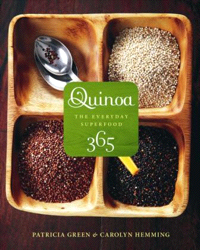It’s not just that it’s the future food of astronauts to Mars, according to NASA.
It’s the basic nutrition that comes packed in a grain that grows in less desirable soils, thanks to its spartan upbringing in the Andes by the Incas.
So say Claire Burnett, MSc, and Laurie Scanlon, PhD, of Keen Ingredients, Inc., in their impressive introduction to Quinoa (Whitecap 2010), entitled “The Mystery and History of Quinoa.”
It’s quinoa time — but authors Patricia Green and Carolyn Hemming do not follow up this scientific act sufficiently.
Oh, their cookbook bulges with quinoa-adapted recipes! But missing is real creativity with the “pseudocereal” grain itself. In fact, where are the recipes of Peru and Bolivia, for starters? Are the other ingredients too hard to find? Or do the authors believe them uninteresting to the curious-types who would shuck out for a curio cookbook like Quinoa?
 Otherwise, recipes tend to target the already-organic (like “Blueberry Flax Hot Cereal,” p. 13) or the hearty, Mediterranean-Middle Eastern (like “Cucumber Mint Salad,” p. 45). Off the authors go, substituting quinoa for other ingredients or simply adding it as a hidden health supplement. Thus, we find for soups “Beef Vegetable Quinoa Soup” (p. 61, with quinoa for barley) and “Roasted Red Pepper Tomato Soup” (p. 70, with quinoa flour added). These recipes are a just a good reminder to reach for the versatile grain and add it instead of other grains.
Otherwise, recipes tend to target the already-organic (like “Blueberry Flax Hot Cereal,” p. 13) or the hearty, Mediterranean-Middle Eastern (like “Cucumber Mint Salad,” p. 45). Off the authors go, substituting quinoa for other ingredients or simply adding it as a hidden health supplement. Thus, we find for soups “Beef Vegetable Quinoa Soup” (p. 61, with quinoa for barley) and “Roasted Red Pepper Tomato Soup” (p. 70, with quinoa flour added). These recipes are a just a good reminder to reach for the versatile grain and add it instead of other grains.
There is no issue about “Where’s the beef?” here, but there is some issue over real value add. How about a more intriguing yet descriptive title? A la horror movie: The Ghost of Quinoa? A la suspense: The Quinoa Proxy? Or a pure grabber: The Supplanter?
There are no politics here, either: nothing about sustainable agriculture, slow food, etc. The issue is not about beef at all: where’s the sexiness in quinoa?
Clearly, Quinoa 365‘s message is that this non-grain grain should be for “everyday,” but whether it is inspiring is another issue.

I like the book. I already bought 5 for friends. I also have 2 other recipe books about quinoa and I would not give them as gifts. They are UGLY and the recipes seem untested.
This book is revolutionary in that it makes quinoa-an intimidating ingredient for many- easy to incorporate in our every day diets.
-S
I think “Superchef” is missing the point about “Quinoa 365”. It’s an INTRODUCTION to the superfood and hence, it makes sense that the recipes are simple, accessible and straightforward. It is not intended as a political statement or as a cookbook of international cuisine. It is intended to introduce the everyday, average person to this little-known superfood. In providing nutritional information and history of the non-grain grain and simple recipes, it shows readers how easy it is to add this food to their already tried and true recipes when so many recipes which include quinoa are simply “couscous-type” dishes. Is the book inspiring? Gee, I don’t know – of the literally, DOZENS of people to whom I’ve introduced the book, whether vegetarian, diabetic, gluten-sensitive, etc., they’ve all said “thank you! I’m excited about food again! I’m excited to cook again!”
Sounds to me from “Superchef”s” review like a case of sour grapes – wish you thought about writing the book first? And by the way, the book may have been published this year, but this phenomenal bestseller and labour of love has been in the works and test kitchens for 3 years. How many cookbooks can claim victory over Jamie Oliver on the bestseller lists?
Stef Farkas, this is just a review, not sour grapes — and Super Chef publishes one and sometimes more reviews per week, which you can read in our new format at https://superchef.us/?cat=5 and in our previous format at https://superchef.us/1990/11/cookbook-reviews.html .
The present review stands on criticism that is clearly constructive. Its gist is to suggest what seems missing. You may not find new foods politically loaded or internationally oriented: clearly, that is your opinion.
Your insight into just what this book is about raises a question: do you have any ties to this book beyond admiration? (Your description and attack suggest the possibility of a closer connection.)
Lastly, this cookbook may well rank high in sales and reflect on three years of work that went into it — but are you suggesting that many other cookbooks cannot make the same claim?